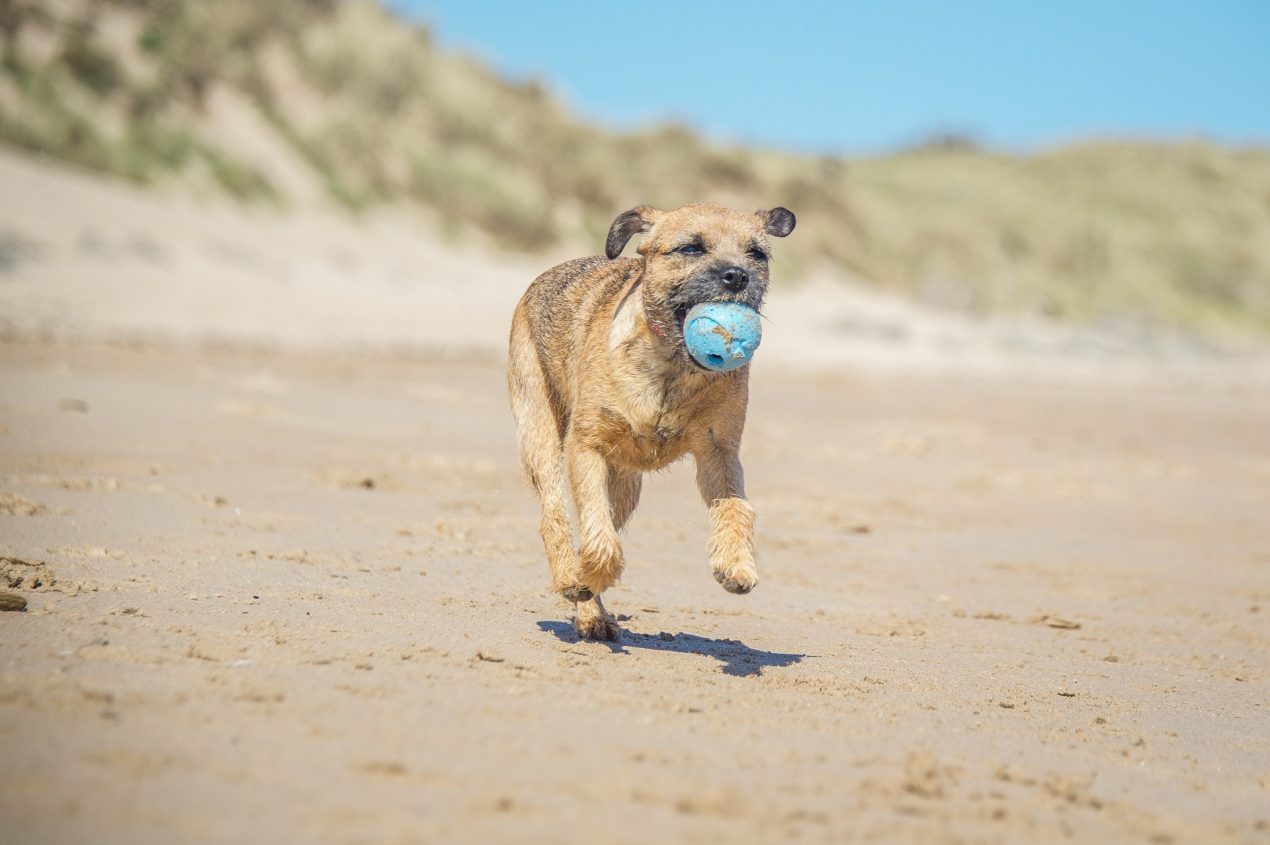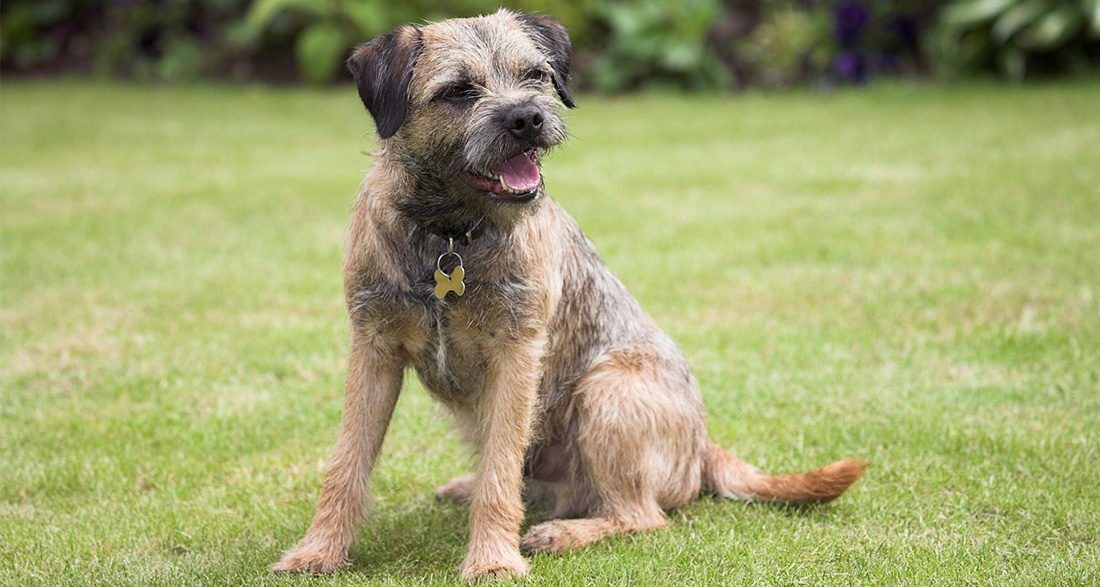In the United Kingdom, the Border Terrier is a popular breed for families and hunters. In other countries, the Border Terrier breed is less commonly seen, but its popularity is steadily increasing. Below, you’ll find what makes this adventurous four-legged companion stand out.
History of the Border Terrier
The Border Terrier was once native to the border area between England and Scotland. Hence, its name. However, it’s unclear where its original ancestors came from. It is believed to be related to the Dandie Dinmont Terrier and Bedlington Terrier. Images of a dog resembling it date back to the 18th century. However, it was selectively bred starting from the 20th century in the UK. It was bred as a hunting dog, especially for fox hunting. It needed to be fast to keep up with the hunter on horseback and not too large to fit into fox burrows. Even today, its excellent hunting services are utilized.
The Border Terrier was recognized as an English breed by the Kennel Club in 1920 and by the FCI in 1963. It is listed under FCI standard number 10, FCI Group 3 “Terrier,” Section 1 “Large Terriers.” The Border Terrier was recognized as a breed by the AKC in 1930.
Breed Overview
GROUP: Terrier
HEIGHT: 12 to 15 inches
WEIGHT: 11.5 to 14 pounds (female), 13 to 15.5 pounds (male)
COAT: Short, wiry
COAT COLOR: Blue and tan, grizzle and tan, red, or wheaten; muzzle is usually darker
LIFE SPAN: 12 to 15 years
TEMPERAMENT: Lively, bright, affectionate
HYPOALLERGENIC: Yes
ORIGIN: United Kingdom
Appearance of the Border Terrier
The Border Terrier is often mistaken for a mixed breed due to its appearance. Its head is distinctive, resembling that of an otter. The rough, wiry, weather-resistant coat of the Border Terrier comes in colors ranging from blue and tan, red, wheaten, to grizzle and tan. Black often adorns the area around its muzzle, the muzzle itself, its alert, cheeky almond-shaped eyes, and the tops of its small, dropped ears. With a size ranging from 28 to 40 centimeters, it belongs to the small to medium-sized breeds. The four-legged friend possesses long, slender legs. It always carries its high-set, bushy tail straight.
Temperament and Character
The Border Terrier’s character can be described as cheerful, lively, and intelligent. While the Border Terrier barks occasionally, it is by no means a yapper. Bred as a hunting dog for the pack, it is very sociable with its fellow canines. This curious four-legged friend is characterized by a strong hunting instinct and an excellent sense of smell. Hence, it enjoys venturing out independently when something catches its scent. If not trained well on recall from an early age or if the garden is not escape-proof, it’s hard to keep it contained. Neither hedges nor water can deter it, as the former otter hunter loves water and is well protected by its robust coat. The working dog is very enduring and can work for hours during hunting, in any weather conditions.
As the Border Terrier is very playful but not aggressive, it is also an ideal family dog for active owners with children. The children should be somewhat older, as it can be quite boisterous during playtime. It gets along well with other dogs in the household but less so with cats, as its hunting instinct will prevail. The fearless terrier reliably protects its home by alerting to anything unusual with barking. Its friendliness extends to welcome visitors of its human pack.
| Affection Level | High |
| Friendliness | High |
| Kid-Friendly | High |
| Pet-Friendly | Medium |
| Exercise Needs | Medium |
| Playfulness | High |
| Energy Level | Medium |
| Trainability | Medium |
| Intelligence | High |
| Tendency to Bark | Medium |
| Amount of Shedding | Low |
Acquiring a Border Terrier
Is the Border Terrier right for me?
The cheerful, agile four-legged companion is suitable for active individuals, whether as singles or families with children. Since it can be trained with consistency and requires a lot of time and attention, it is suitable for novice owners who can provide it with a home. Seniors may not be as suitable for this energetic terrier.
Border Terrier Price:
If you’re looking to buy a Border Terrier, you can expect to pay around $800 to $1000 from reputable breeders. This price is justified as breeders conduct expensive genetic tests and health examinations to ensure the well-being of their animals. It is strongly advised to steer clear of puppies offered at excessively low prices.

What should I look out for when buying?
Only purchase a puppy from a reputable Border Terrier breeder registered with a breed association. Good breeders only allow healthy parent animals for breeding to eliminate hereditary diseases in their puppies. They can provide appropriate genetic tests for both parent animals.
A responsible breeder will not release puppies before the age of 8 weeks. At that time, they will provide vaccination records and registration papers. Their puppies will have been microchipped, dewormed multiple times, and undergone health checks. A good breeder will allow potential buyers to meet the puppies before purchase. This allows you to assess whether they come from a good home. Don’t be surprised if the breeder asks you many questions. They want to ensure their puppies will have a good new home.
Development and training of the puppy
The Border Terrier is highly intelligent and trainable. With lots of love, patience, and above all, consistency, you can teach the little terrier who’s in charge from an early age. Once accepted as the pack leader, the independently thinking hunting dog will learn easily, which can be quite overwhelming for a puppy at first. For example, it needs to learn rules for interacting with its new human pack, possibly meet other pets, learn commands like sit and stay, get used to riding in the car, and grooming. Regular recall training is especially important. A visit to a dog training school will benefit it greatly. There, it can play and interact with other dogs and learn to socialize effectively.
How do I care for a Border Terrier?
The energetic four-legged friend feels most comfortable in a house with a garden, ideally not far from nature. However, since it is quite small, it can also live in a smaller apartment as long as it receives plenty of exercise and appropriate mental stimulation.
Activities with the Border Terrier:
In the UK, this cheerful companion is still used as a hunting dog, especially for foxes. It loves hunting and sniffing in the woods and nature. If it lives in a family, its strong need for exercise should be considered. The Border Terrier requires about 1-2 hours of activity daily. You can take long walks with it, preferably on a long leash, as even with early training, the recall of a hunting dog is never one hundred percent guaranteed. You can also lay some tracks for it along the way. The adventurous working dog also needs mental stimulation and particularly loves scent work. Its excellent sense of smell and balanced temperament make it suitable for therapy work.
At home, the four-legged friend enjoys anything that alleviates boredom: intelligence games, food searches, and learning tricks. In the garden or on walks, you can play frisbee, fetch balls, or dummies with it. Dog sports also provide mental stimulation. Whether it’s dog dancing, agility, or tracking sports, the intelligent four-legged friend learns quickly and participates enthusiastically.
Since it was bred for hunting on horseback, it can easily run alongside while horse riding. However, this should only be done when it’s fully grown and gradually accustomed to the pace. Jogging and cycling with this energetic nature lover are also suitable activities. Make sure the lively terrier gets enough rest after each activity to prevent it from getting “overexcited.”

Health and Care
Border Terriers are considered robust, resilient dogs that show almost no specific health issues. Occasionally, these dogs may have hip dysplasia, a hereditary malformation of the hip joint, progressive retinal atrophy, an inherited disease that causes blindness, and heart conditions. Additionally, the hereditary condition CECS, which leads to seizures, has been observed in Border Terriers.
To ensure your Border Terrier remains healthy and fit for a long time, it’s essential to provide them with high-quality food. It should have a high meat content, sufficient minerals, and vitamins. Avoid additives, chemical preservatives, sugar, and ideally no grains. Pay attention to the recommended feeding amount, which should always be adjusted to your dog’s activity level, age, and health condition. Regular weighing of your furry friend helps prevent unhealthy weight gain.
The grooming of the hunting dog is quite simple. They shed minimally, and weekly brushing is usually sufficient. However, during shedding season, daily brushing is recommended. For this purpose, they should visit a dog groomer for trimming twice a year, or you can purchase a trimmer yourself. Since they enjoy roaming in the woods and meadows, especially during tick season (approximately from March to October/November), it’s crucial to check their coat for these pesky parasites after walks. There are also tick collars or tablets available to combat these little pests.
Their floppy ears also need regular inspection, as they are more prone to infections due to poor ventilation. Special ear cleaners designed for dogs can easily remove any buildup from their ears. Additionally, you should regularly brush your energetic companion’s teeth with a dog toothbrush and toothpaste. This helps prevent tartar buildup and reduces the risk of needing to remove decayed teeth in old age. Providing daily chew treats such as dried cow ears, beef scalp, or dental care sticks allows them to engage in self-dental care. For senior dogs, you may need to trim their nails if they become too long to prevent them from getting caught and torn, which can be very painful.
Interesting Facts
A prominent owner of a Border Terrier named “Holly” is the former German Chancellor Gerhard Schröder.
Border Terrier Overview
Pros
- Affectionate and friendly
- Adaptable
- Energetic and hardy
Cons
- Can be strong-willed
- Can have a high prey drive
- Often prolific diggers
Do you own a Border Terrier or plan to get one? Share with me in the comments what makes them special in your opinion!


